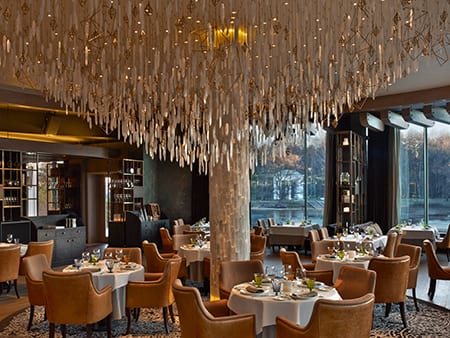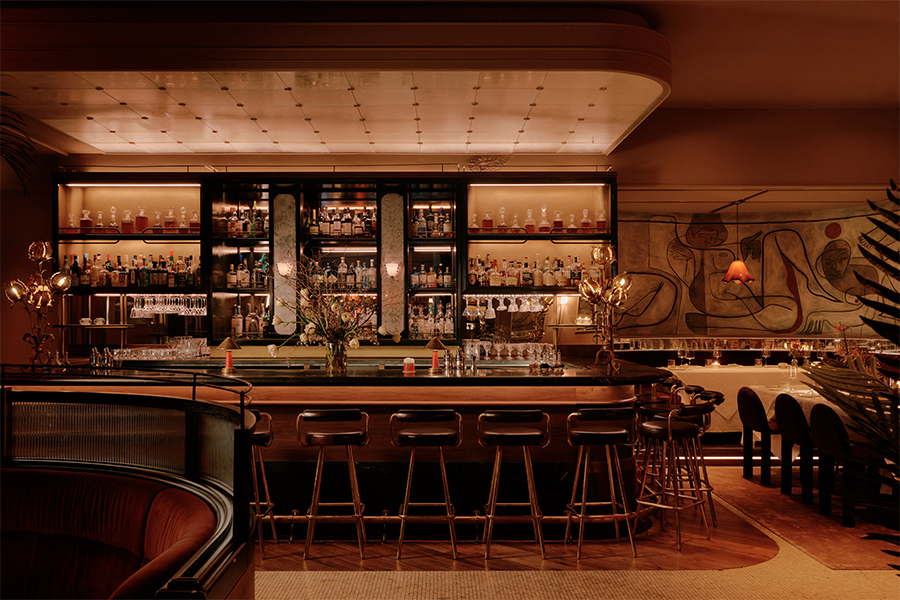Inspired by Peter Tchaikovsky’s “Swan Lake,” one St. Petersburg restaurant blends the ballet’s romance with Russian folklore and history. Il Lago dei Cigni-which translates to “swan lake” in Italian-overlooks a swan-filled pond from its Krestovsky Island location. “The restaurant is next to a swan house, where the birds live and breed, so this was the basis for the concept we developed,” says designer Inge Moore of London-based Gallery HBA.
.jpg)
Just as Tchaikovsky’s ballet features folkloric elements, Moore’s team incorporated aspects of fairytale and local history into Il Lago die Cigni’s design. An array of curiosities set in timber cabinets in the entrance hall and wine room pays homage to Peter the Great, the tsar of Russia in the late 17th century. During his reign, the tsar invested in palaces, ships, and engineering projects to transform the city and progress into modernity. “These legends formed a perfect foundation for our storyline,” says Moore.
.jpg)
“[The island] is an enclave where the great and the good of the city reside and enjoy its equestrian and yacht clubs,” says Moore, “so we created a style that would feel fresh and capture the imaginations of its sophisticated clientele.” Glass domes exhibit mounted beetles and butterflies and magnifying glasses enlarge wine bottle labels, turning them into art pieces also featured in the cabinets. Bound together with string, bundles of old French manuscripts lie alongside framed pen and ink studies of swans.
.jpg)
“We selected natural materials, sometimes in their raw states, to emphasize the untamed spirit of the ambience we wanted to achieve,” explains Moore. Wide plank floors accentuate the restaurant’s rustic side, while antique bronzed glass and backlit selenite panels add sparkle to the room. Fabric patterns offer modern renditions of traditional Russian textile motifs and scrolled floral patterns on some chair cushions in embossed metal relief recall Slavic textile design.
.jpg)
Other seating upholstered in cognac leather and truffle-toned herringbone wool draws a connection to nature. “We selected natural tones that would relate with the wild landscape,” Moore says. The cut-and-loop espresso and cream carpeting copies the pattern of lace doilies for a hint of femininity.
.jpg)
“Our aim has been to translate the ballet’s intensity, passion, and romance into Il Lago dei Cigni’s dramatic décor,” says Moore. The bar continues the ambiance of the dining area with a teak wood top, leather chairs, and touches of hammered copper. Hand-blown Czech glass and a backlit façade of selenite rock illuminate the bar.
.jpg)
The central dining area has an even more dramatic source of light. A grand center column and chandelier allude to maypole dancing, which celebrates the solstice and the rhythms of nature in Russian lore. Clad in selenite rock crystal, the pillar’s effervescent glow vanishes into a circular backlit soffit at the ceiling. Crystals mimic ribbons around the pillar and are interspersed with geometric copper wire talismans.
.jpg)
The maypole is Moore’s favorite aspect of the design. “When kids enter the room, they run to touch it,” she says, “and the adults would do the same if they practiced less restraint.”



